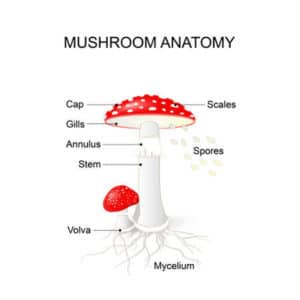
Psilocybin Mushroom Anatomy 101
Do you know the the parts of a psilocybin mushroom fruiting body or where the spores are located?
Knowing psilocybin mushroom anatomy is essential to being an educated mushroom consumer. In this article, Frshminds gives you the lowdown on the parts of the psilocybin mushroom.
Parts of a Psilocybin Mushroom

When most people think of a mushroom, they usually think of fleshy, usually bulbous, spore-bearing fruiting body of a fungus, typically produced above ground, usually a run of the mill white button mushroom, the term “Mushroom” describes a variety of other gilled fungi. Mushrooms are more than meets the eye – the part you see is just part of the action. The visible, above ground part of a mushroom is called the ‘fruiting body’ (as in fruits and flowers, it emerges in order to shed spores to reproduce). The mycelium is the subterranean part; they are reminiscent of plant roots, although they also play a larger role, connecting fields of mushrooms to eachother. They absorb nutrients to help the fruiting body grow, and they can live for many years, even after the fruiting body dies.
While all mushrooms are from the same toxaemic order (Agaricales), they are from different families, so psliocybin mushroom anatomy is quite different then that of other mushrooms. We will run through these structures below.
The Cap
Hard to describe something that is more appropriately named. This part of the fruiting body is advantageous, as evolution goes, in protecting the gills, stem and spores from the elements. The cap is perhaps best thought of as the ‘skull’, holding and protecting the important elements beneath it.
Mushroom Stem
Raising the spores and gills up from the ground likely makes them spread more easily and widely. So again, evolution led to the presence of the stem, whose only goal, really, is to help the fruiting body get as far off the ground as possible.
Mushroom Gills
Unlike a fish, where the gills are used to intake water and extract oxygen, these gills house and distribute the spores that allow the shroom to reproduce.
Mushroom Spores
Much like a flower, mushrooms spread by releasing their seeds broadly into the air at the end of the season. When these spores penetrate the earth (or dung, or whatever surface they prefer), they actually create their own mycelium root structure, also much like a flower.
When the nutrient-collecting arms, or hyphae, of a mushroom start to spread in search of food, they come in contact with those from other mushrooms. Mushroom growth builds from the spore upward. The spore begins to reproduce and creates the early forms of its fruiting body. This is called the ‘button stage’, though it doesn’t stay a button for very long – buttons become mushrooms very fast (like days, not weeks).
The Mycelium
The mycelium are somewhat mysterious parts of a mushroom. Their thin fibers are, again, reminiscent of plant roots, and similarly hunt for food. But mycelium are now understood to form vast underground networks between fruiting bodies, sharing information, nutrients and who knows what else (some say, emotions, but we will stick with objective fact here).
Hypha
A hyphae have two phases of existence. First, in the growth phase, they extend outwards from the mycelium to absorb water and food for the organism. As the get closer to maturity, they break through the surface and begin to create a fruit body of their own.
Volva
This is the remnants of the mushroom at its earliest stage of development. It initially protected the infant fruiting body, but was destroyed as the body pushed upwards out of the ground.
Ring
Another holdover from infancy, this membrane covered the gills and ruptured as the body grew, leaving only a ring of material.
Magic Mushrooms 101
If you are looking to get up to speed on magic mushrooms, these articles on Frshminds will get you there in no time:

Comments